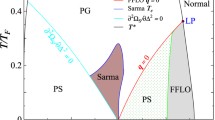Abstract
We investigate the superfluid phase transition and effects of mass imbalance in the BCS (Bardeen-Cooper-Schrieffer)-BEC (Bose-Einstein condensation) crossover regime of an cold Fermi gas. We point out that the Gaussian fluctuation theory developed by Nozières and Schmitt-Rink and the T-matrix theory, that are now widely used to study strong-coupling physics of cold Fermi gases, give unphysical results in the presence of mass imbalance. To overcome this problem, we extend the T-matrix theory to include higher-order pairing fluctuations. Using this, we examine how the mass imbalance affects the superfluid phase transition. Since the mass imbalance is an important key in various Fermi superfluids, such as 40K-6Li Fermi gas mixture, exciton condensate, and color superconductivity in a dense quark matter, our results would be useful for the study of these recently developing superfluid systems.




Similar content being viewed by others
Notes
The key to overcome the breakdown of TMA in the spin-polarized case is that, when the full Green’s function G is used in the fermion loop as shown in Fig. 1(b), the RPA-type series of spin fluctuations are correctly taken into account [17]. In TMA, where the bare Green’s function G 0 is used for the fermion loop, the RPA series is truncated, leading to the unphysical non-positive-definite susceptibility. The so-called GG 0-theory also uses G 0 in the fermion loop (although G is partially used in the ladder diagram), so that it does not include spin fluctuations within RPA. Since the self-consistent T-matrix theory (GG-theory) [20] uses Fig. 1(b)-type self-energy, it can be also applicable to the spin-polarized system, as well as the mass-imbalanced system, as ETMA.
References
C.A. Regal, M. Greiner, D.S. Jin, Phys. Rev. Lett. 92, 040403 (2004)
S. Giorgini et al., Rev. Mod. Phys. 80, 1215 (2008)
I. Bloch et al., Rev. Mod. Phys. 80, 885 (2008). and references are therein
G. Sarma, J. Phys. Chem. Solids 24, 1029 (1963)
J.E. Baarsma, K.B. Gubbels, H.T.C. Stoof, Phys. Rev. A 82, 013624 (2010)
K. Yoshioka, E. Chae, M. Kuwata-Gonokami, Nat. Commun. 2, 328 (2011)
J. Kasprzak, M. Richard, S. Kundermann, A. Baas, P. Jeambrun, J.M.J. Keeling, F.M. Marchetti, M.H. Szymańska, R. André, J.L. Staehli, V. Savona, P.B. Littlewood, B. Deveaud, L.S. Dang, Nature 443, 409–414 (2006)
B.C. Barrois, Nucl. Phys. B 129, 390 (1977)
S.C. Frautschi, in Hadronic Matter at Extreme Energy Density, ed. by N. Cabibbo, L. Sertorio (Plenum, New York, 1980)
D. Bailin, A. Love, Phys. Rep. 107, 325 (1984)
M. Taglieber, A.-C. Voigt, T. Aoki, T.W. Hänsch, K. Dieckmann, Phys. Rev. Lett. 100, 010401 (2008)
P. Nozières, S. Schmitt-Rink, J. Low Temp. Phys. 59, 195 (1985)
D. Rohe, W. Metzner, Phys. Rev. B 63, 224509 (2001)
A. Perali, P. Pieri, G.C. Strinati, C. Castellani, Phys. Rev. B 66, 024510 (2002)
S. Tsuchiya, R. Watanabe, Y. Ohashi, Phys. Rev. A 80, 033613 (2009)
D.J. Thouless, Ann. Phys. (N.Y.) 10, 553 (1960)
T. Kashimura, R. Watanabe, Y. Ohashi. arXiv:1207.2570
X.-J. Liu, H. Hu, Europhys. Lett. 75, 364 (2006)
M.M. Parish, F.M. Marchetti, A. Lamacraft, B.D. Simons, Nat. Phys. 3, 124 (2007)
R. Haussmann, Phys. Rev. B 49, 12975 (1994)
Acknowledgements
We thank S. Watabe and Y. Endo for useful discussions. This work was partially supported by Institutional Program for Young Researcher Oversea Visits from the Japan Society for the Promotion of Science. Y.O. was supported by Grant-in-Aid for Scientific research from MEXT in Japan (22540412, 23104723, 23500056).
Author information
Authors and Affiliations
Corresponding author
Rights and permissions
About this article
Cite this article
Hanai, R., Kashimura, T., Watanabe, R. et al. Superfluid Phase Transition and Strong-Coupling Effects in an Ultracold Fermi Gas with Mass Imbalance. J Low Temp Phys 171, 389–396 (2013). https://doi.org/10.1007/s10909-012-0738-9
Received:
Accepted:
Published:
Issue Date:
DOI: https://doi.org/10.1007/s10909-012-0738-9




